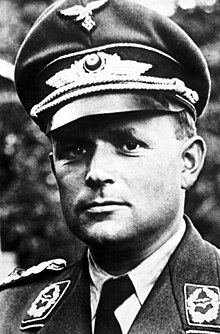Walter Lehweß-Litzmann
Walter Lehweß-Litzmann (* 5. June 1907 in Bromberg , Posen ; † 16th September 1986 in Wildau in Berlin ) was commodore of a combat squadron and Ritterkreuzträger in World War II , from 1952 head of the pilot training of the KVP and NVA - air forces and from 1959 Director of the flight operations of Interflug in the GDR .
Life
Walter Lehweß-Litzmann was born as a son of the government builder and architect Walter Lehweß (grandson of the publisher and politician Franz Duncker ) and Amélie nee. Litzmann (daughter of General of the Infantry Karl Litzmann ), grew up in Berlin from 1908 and graduated from high school in 1925 .
Military career
Education and Uses
In 1925 Walter Lehweß-Litzmann entered the Reichswehr cavalry as an officer candidate . In 1929 he became a lieutenant in the 4th (Prussian) cavalry regiment in Potsdam and completed a private training as a pilot in 1933 . In the same year he crashed in Berlin-Staaken, was seriously injured and at the beginning of 1934 was transferred to the air force, which was initially still camouflaged, to the long-range reconnaissance group in Prenzlau . After the official formation of the Air Force in 1935, he became a captain and squadron captain. Then he worked in staffs in southern Germany in the construction of the Luftkreis and Luftflotte 3 and in 1938 in the integration of the Austrian air force. 1939, after graduating from the General Staff Academy and becoming a major i. G. promoted, he was the first general staff officer (Ia) involved in setting up the 6th Aviation Division in Frankfurt am Main .
At Christmas 1939 he married the medical student Ingeborg Meyer, granddaughter of Professor Lothar Meyer , who later became a leading aviation doctor in the GDR in Dresden . In 1940 he was employed in the staff of the X. Fliegerkorps (Ia) (from May 1940 Luftflotte 5 ), which played a key role in the occupation, conquest and security of Denmark and Norway. In 1941 he took over as commander of the III. Group in Kampfgeschwader 1 "Hindenburg", which he led mainly in night missions against the United Kingdom , from June against the Soviet Union in the northern section. At the end of 1941 he was ordered to set up and lead a special air force staff in Finland and was appointed lieutenant colonel i. G. appointed. In this capacity he also led the associations in the summer of 1942 as Fliegerführer Nord-Ost against the northern convoys in the northern Arctic Ocean, on the Kola Front and against the ice-free port of Murmansk , for which he was awarded the German Cross in Gold. In early 1943, he took over at the eastern front (center portion) as a Commodore the kampfgeschwader 3 and fell in September by a spectacular partisans stop, under the direction of Anna Morozova , in Soviet captivity. On September 7, 1943 , he was thrown from the plane while flying the Ju 88 in his armored seat, which probably saved his life, and landed with a parachute. Reported as "fallen" by the German side, he was retrospectively made Colonel i. G. promoted and honored with the Knight's Cross on October 29, 1943 .
In April 1944 he joined the National Committee for Free Germany as the highest ranking air force officer and worked in its media against Hitler and an extension of the war.
After the Second World War
In December 1945 he was sent to Germany to set up the Berliner Zeitung and to work in its editorial office. In 1952, with his previous rank as Colonel, he became chief of aviation training for the barracked People's Police Air , then until 1959 commander of the Kamenz Aviation School , later the OHS of the LSK / LV .
Promotions
- 1925 officer candidate
- 1929 lieutenant (appointment)
- k. A. First Lieutenant
- 1935 captain
- 1939 Major i. G.
- 1941 Lieutenant Colonel i. G.
- 1943 Colonel i. G.
- 1952 Colonel of the CIP readiness for air
Director of flight operations at Interflug
From 1959 to 1970 he was director of the flight operations of Deutsche Lufthansa (GDR) (from 1963 Interflug ), where he shaped this significantly.
After a serious car accident, he retired in early 1970 due to health reasons. He died in 1986 and, although almost forgotten, received a major funeral service with civil and military honors in Berlin.
literature
- Jörn Lehweß-Litzmann: An unusual aviation life. in: Peter Bork (ed.): Fliegerkalender der DDR 1987. Military Publishing House of the GDR, Berlin 1986, pp. 196–206.
- Jörn Lehweß-Litzmann: Crash into life , Dingsda-Verlag, Querfurt 1994, 331 pages, ISBN 3-928498-34-7
- Jörn Lehweß-Litzmann: The founders of GDR aviation , Military Publishing House , Berlin 2010, ISBN 978-3-360-02703-0
- Bernd-Rainer Barth : Lehweß-Litzmann, Walter (originally Walter Lehweß) . In: Who was who in the GDR? 5th edition. Volume 1. Ch. Links, Berlin 2010, ISBN 978-3-86153-561-4 .
Web links
- Literature by and about Walter Lehweß-Litzmann in the catalog of the German National Library
Individual evidence
- ↑ Jörn Lehweß-Litzmann: An unusual aviation life. In: Peter Bork (Ed.): Fliegerkalender der DDR 1987. Military Publishing House of the GDR, Berlin 1986, p. 196.
| personal data | |
|---|---|
| SURNAME | Lehweß-Litzmann, Walter |
| BRIEF DESCRIPTION | German officer and fighter pilot |
| DATE OF BIRTH | June 5, 1907 |
| PLACE OF BIRTH | Bromberg |
| DATE OF DEATH | September 16, 1986 |
| Place of death | Wildau |
